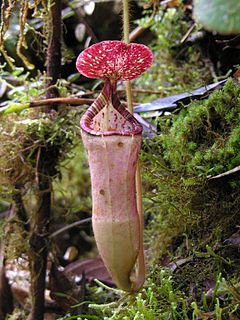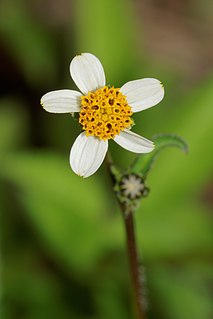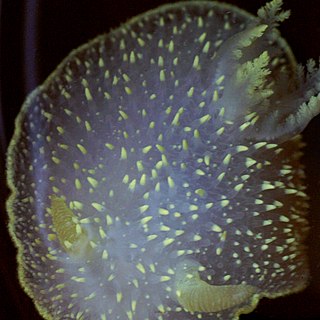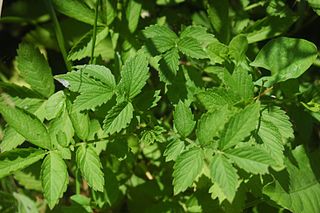
The order Pilosa is a group of placental mammals, extant today only in the Americas. It includes the anteaters and sloths, including the extinct ground sloths, which became extinct about 10,000 years ago. The name comes from the Latin word for "hairy". Pilosans are good examples of ecological harmony. Anteaters, for example, feed lightly and for a short time at any one ant nest, allowing the colony to regrow easily. Also, sloths' fur is home to many insects, as well as a type of algae that helps camouflage the sloths.

Nepenthes pilosa is a tropical pitcher plant endemic to Borneo. It is characterised by a dense indumentum of long yellow-brown hairs. Pitchers have a distinctive hook-shaped appendage on the underside of the lid. The specific epithet derives from the Latin word pilosus, meaning "hairy".

Nepenthes chaniana is a tropical pitcher plant species belonging to the genus Nepenthes. It is characterised by a dense indumentum of long, white hairs. Pitchers are cylindrical and mostly white to yellow in colouration. Nepenthes chaniana belongs to the loosely defined "N. maxima complex", which also includes, among other species, N. boschiana, N. epiphytica, N. eymae, N. faizaliana, N. fusca, N. klossii, N. maxima, N. platychila, N. stenophylla, and N. vogelii.

Bidens pilosa is a species of flowering plant in the aster family. It is native to the Americas but it is known widely as an introduced species of other regions, including Eurasia, Africa, Australia, and the Pacific Islands. It is a tall branched weed with thin yellow flowers that develop into a cluster of barbed fruits. Its many common names include black-jack, beggar-ticks, cobbler's pegs, farmer's friends and Spanish needle. The fruits are like short, stiff hairs. They get stuck in feathers, fur, or socks, etc. This bur is widespread throughout the warmer regions of the world. Its little black fruits hook onto clothes or horses and thereby the bur spreads itself around. It is susceptible to hand weeding if small enough, even then must be bagged, and thick mulches may prevent it from growing. Each fruit has two to four barbed spines. A weed of gardens, woodlands, and waste areas, a person who brushes against it will end up covered in the burs and need to pick them off one by one. Although this plant is considered a weed in some parts of the world, in other parts it is a source of food or medicine. For example, it is reportedly widely eaten in Africa, and in Vietnam, during the Vietnam War soldiers adopted the herb as a vegetable, which lead to it being known as the "soldier vegetable".

Grevillea pilosa is a low growing shrub which is endemic to the south-west of Western Australia. It grows to between 0.4 and 1 metre in height and produce red or pink flowers between June and December in its native range.

Acanthodoris is a genus of sea slugs, dorid nudibranchs, shell-less marine gastropod mollusks in the family Onchidorididae. The genus is believed to have originated in the Atlantic Ocean in the Cretaceous period and spread to the Pacific Ocean. The relationships of Acanthodoris to the other genera in the family Onchidorididae were evaluated by molecular phylogeny in 2015.

Pujalt is a municipality in the comarca of the Anoia in Catalonia, Spain.

Genista pilosa, commonly known as hairy greenweed, silkyleaf broom, silkyleaf woadwaxen and creeping broom, is a plant species in the genus Genista. It is 30–45 centimetres (12–18 in) tall and has green coloured stems. It has yellowish coloured flowers which grow in 1-3 pairs. It grows in Western and central Europe in poor, dry, sandy, and stony soils

Luzula pilosa is a species of flowering plant in the rush family Juncaceae with the common name hairy wood-rush. The plant is native to northern Europe and western Asia.

Agrimonia pilosa, also known as hairy agrimony, is a flowering plant in the family Rosaceae. It is distributed primarily over the Korean Peninsula, Japan, China, Siberia, and Eastern Europe.
Compsosomatini is a tribe of longhorn beetles of the Lamiinae subfamily.
Laraesima is a genus of longhorn beetles of the subfamily Lamiinae.
Laraesima albosignata is a species of beetle in the family Cerambycidae. It was described by Bates in 1885. It is known from Guatemala.
Laraesima asperata is a species of beetle in the family Cerambycidae. It was described by Bates in 1885. It is known from Mexico.
Laraesima ecuadorensis is a species of beetle in the family Cerambycidae. It was described by Stephan von Breuning in 1974. It is known from Ecuador.
Laraesima fuliginea is a species of beetle in the family Cerambycidae. It was described by Bates in 1885. It is known from Mexico and Guatemala.
Laraesima hispida is a species of beetle in the family Cerambycidae. It was described by Thomson in 1868. It is known from Brazil.
Laraesima nitida is a species of beetle in the family Cerambycidae. It was described by Monné in 1980. It is known from Brazil.
Laraesima ochreoapicalis is a species of beetle in the family Cerambycidae. It was described by Stephan von Breuning in 1973. It is known from Brazil.
Laraesima scutellaris is a species of beetle in the family Cerambycidae. It was described by Thomson in 1868. It is known from Argentina and Brazil.











